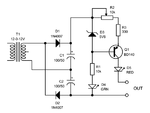Pjdd
Advanced Member level 2

I made this very basic variable constant-current source a long time ago for one specific purpose. It was meant to help me sort out an old collection of assorted zener diodes, most of which had had their numbers worn off. In some cases, I also wanted to evaluate their dynamic resistance. It has a range of about 0.5mA to 15mA.
It's one of my numerous minor projects and the performance is good enough for the stated purpose. There are alternative circuits with better performance, but this one is as simple as it gets and uses cheap commonly available parts. I expected to discard it after using it for for the said purpose but now, some 30 years later, I'm still using it for purposes other than the original one.
In case anyone is interested in making one for his/her own use, I can upload the PCB layout and add other details.

It's one of my numerous minor projects and the performance is good enough for the stated purpose. There are alternative circuits with better performance, but this one is as simple as it gets and uses cheap commonly available parts. I expected to discard it after using it for for the said purpose but now, some 30 years later, I'm still using it for purposes other than the original one.
In case anyone is interested in making one for his/her own use, I can upload the PCB layout and add other details.
